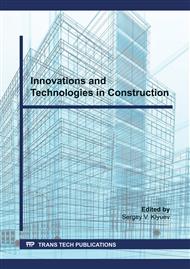[1]
E.F.S. Ciacco, J.R. Rocha, A.R. Coutinho, The energy consumption in the ceramic tile industry in Brazil, Appl. Therm. Eng. (2017). https://doi.org/10.1016/j.applthermaleng.2016.11.068.
Google Scholar
[2]
J.A. Cusidó, L.V. Cremades, C. Soriano, M. Devant, Incorporation of paper sludge in clay brick formulation: Ten years of industrial experience, Appl. Clay Sci. (2015). https://doi.org/10.1016/j.clay.2015.02.027.
DOI: 10.1016/j.clay.2015.02.027
Google Scholar
[3]
U. Arena, Process and technological aspects of municipal solid waste gasification. A review, Waste Manag. (2012). https://doi.org/10.1016/j.wasman.2011.09.025.
DOI: 10.1016/j.wasman.2011.09.025
Google Scholar
[4]
R.S. Fediuk, V.S. Lesovik, A.P. Svintsov, A.V. Mochalov, S.V. Kulichkov, N.Y. Stoyushko, N.A. Gladkova, R.A. Timokhin, Self-compacting concrete using pretreatmented rice husk ash, Mag. Civ. Eng. 79 (2018). https://doi.org/10.18720/MCE.79.7.
Google Scholar
[5]
J. Alexandre, C.L. de Assis Paula e Silva, A.R.G. de Azevedo, G. de Castro Xavier, V.S. Candido, S.N. Monteiro, Processing and properties of soil-cement blocks incorporated with natural grit, in: Mater. Sci. Forum, 2014. https://doi.org/10.4028/www.scientific.net/MSF.798-799.343.
DOI: 10.4028/www.scientific.net/msf.798-799.343
Google Scholar
[6]
S.V. Klyuev, A.V. Klyuev, E.S. Shorstova, Fiber concrete for 3-d additive technologies, Construction Materials and Products. 2 (4) (2019) 14–20.
DOI: 10.34031/2618-7183-2019-2-4-14-20
Google Scholar
[7]
S.V. Klyuev, A.V. Klyuev, E.S. Shorstova, The micro silicon additive effects on the fine-grassed concrete properties for 3-d additive technologies, Materials Science Forum. 974 (2019) 131–135.
DOI: 10.4028/www.scientific.net/msf.974.131
Google Scholar
[8]
S.V. Klyuev, A.V. Klyuev, E.S. Shorstova, Fiber concrete for 3-d additive technologies, Materials Science Forum. 974 (2019) 367–372.
DOI: 10.4028/www.scientific.net/msf.974.367
Google Scholar
[9]
E.B. Zanelato, J. Alexandre, A.R.G. de Azevedo, M.T. Marvila, Evaluation of roughcast on the adhesion mechanisms of mortars on ceramic substrates, Mater. Struct. Constr. (2019). https://doi.org/10.1617/s11527-019-1353-x.
DOI: 10.1617/s11527-019-1353-x
Google Scholar
[10]
M.R.M. Saade, M.G. da Silva, V. Gomes, H.G. Franco, D. Schwamback, B. Lavor, Material eco-efficiency indicators for brazilian buildings, Smart Sustain. Built Environ. (2014). https://doi.org/10.1108/SASBE-04-2013-0024.
DOI: 10.1108/sasbe-04-2013-0024
Google Scholar
[11]
N.G. Azeredo, E.B. Zanelato, J. Alexandre, A.R.G. De Azevedo, G. De Castro Xavier, V.S. Candido, S.N. Monteiro, Performance of precursor materials and fired ceramics for structural blocks, 2015. https://doi.org/10.4028/www.scientific.net/MSF.820.13.
DOI: 10.4028/www.scientific.net/msf.820.13
Google Scholar
[12]
R. Fediuk, A. Smoliakov, A. Muraviov, Mechanical properties of fiber-reinforced concrete using composite binders, Adv. Mater. Sci. Eng. 2017 (2017). https://doi.org/10.1155/2017/2316347.
DOI: 10.1155/2017/2316347
Google Scholar
[13]
N.A. Cerqueira, M.T. Marvila, A.R.G. De Azevedo, J. Alexandre, G.C. Xavier, V.B. de Souza, S. Un, Analysis of deformability modulus by linear and nonlinear elastic methods in ceramic structural masonry and mortars (Análise do módulo de deformabilidade por métodos elásticos lineares e não lineares em alvenaria estrutural cerâmica e argamassas), 66 (2020) 229–235.
DOI: 10.1590/0366-69132020663792845
Google Scholar
[14]
U.S. do Prado, J.C. Bressiani, Panorama da Indústria Cerâmica Brasileira na Última Década, Cerâmica Ind. (2013). https://doi.org/10.4322/cerind.2014.030.
DOI: 10.4322/cerind.2014.030
Google Scholar
[15]
N.G. Azeredo, J. Alexandre, A.R.G. Azevedo, C.G. Xavier, S.N. Monteiro, E.B. Zanelato, R.P. Oliveira, Evaluation of structural clay brick masonry units by weibull analysis and brazilian code and specifications, in: TMS Annu. Meet., 2015. https://doi.org/10.1002/9781119093404.ch43.
DOI: 10.1002/9781119093404.ch43
Google Scholar
[16]
ABNT, NBR 7181 - Solo - Análise granulométrica, 2016. https://doi.org/01.080.10; 13.220.99.
Google Scholar
[17]
ABNT, NBR 6459: Solo- Determinação do Limite de Liquidez, Assoc. Bras. Normas Técnicas. (1984).
Google Scholar
[18]
ABNT NBR7180, Determinação do Limite de Plasticidade., ABNT, Rio Janeiro, RJ. (1984).
Google Scholar
[19]
ABNT - Associação Brasileira de Normas Técnicas, NBR 6508: Grãos de solos que passam na peneira de 4,8 mm - Determinação da massa específica, (1984).
Google Scholar
[20]
ABNT NBR6457, Amostras de solo: Preparação para ensaios de compactação e ensaios de caracterização., ABNT, Rio Janeiro, RJ. (1986).
Google Scholar
[21]
A.R.G. de Azevedo, J. Alexandre, G. de C. Xavier, L.G. Pedroti, Recycling paper industry effluent sludge for use in mortars: A sustainability perspective, J. Clean. Prod. (2018). https://doi.org/10.1016/j.jclepro.2018.05.011.
DOI: 10.1016/j.jclepro.2018.05.011
Google Scholar
[22]
R. Feduik, Reducing permeability of fiber concrete using composite binders, Spec. Top. Rev. Porous Media. 9 (2018).
DOI: 10.1615/specialtopicsrevporousmedia.v9.i1.100
Google Scholar
[23]
A.R.G. Azevedo, T.M. Marvila, W. Júnior Fernandes, J. Alexandre, G.C. Xavier, E.B. Zanelato, N.A. Cerqueira, L.G. Pedroti, B.C. Mendes, Assessing the potential of sludge generated by the pulp and paper industry in assembling locking blocks, J. Build. Eng. (2019). https://doi.org/10.1016/j.jobe.2019.02.012.
DOI: 10.1016/j.jobe.2019.02.012
Google Scholar
[24]
R. Fediuk, A. Pak, D. Kuzmin, Fine-Grained Concrete of Composite Binder, in: IOP Conf. Ser. Mater. Sci. Eng., 2017. https://doi.org/10.1088/1757-899X/262/1/012025.
DOI: 10.1088/1757-899x/262/1/012025
Google Scholar
[25]
C.M.F. Vieira, R.M. Pinheiro, Incorporation of sedimentary powder rock in roofing tiles body - Part 2: Microstructural evaluation, Ceramica. (2013). https://doi.org/10.1590/S0366-69132013000400002.
Google Scholar
[26]
R. Fediuk, A. Smoliakov, N. Stoyushko, Increase in composite binder activity, in: IOP Conf. Ser. Mater. Sci. Eng., 2016. https://doi.org/10.1088/1757-899X/156/1/012042.
DOI: 10.1088/1757-899x/156/1/012042
Google Scholar
[27]
L.F. Amaral, J.P.R.G. De Carvalho, B.M. Da Silva, G.C.G. Delaqua, S.N. Monteiro, C.M.F. Vieira, Development of ceramic paver with ornamental rock waste, J. Mater. Res. Technol. (2019). https://doi.org/10.1016/j.jmrt.2018.05.009.
DOI: 10.1016/j.jmrt.2018.05.009
Google Scholar
[28]
H. Heystek, CERAMIC RESEARCH AT THE U. S. BUREAU OF MINES., Am. Ceram. Soc. Bull. (1988).
Google Scholar
[29]
C.M.F. Vieira, S.S. Teixeira, S.N. Monteiro, Efeito da temperatura de queima nas propriedades e microestrutura de cerâmica vermelha contendo chamote, Ceramica. (2009). https://doi.org/10.1590/s0366-69132009000300014.
DOI: 10.1590/s0366-69132009000300014
Google Scholar
[30]
R.S. Fediuk, A.K. Smoliakov, R.A. Timokhin, V.O. Batarshin, Y.G. Yevdokimova, Using thermal power plants waste for building materials, in: IOP Conf. Ser. Earth Environ. Sci., 2017. https://doi.org/10.1088/1755-1315/87/9/092010.
DOI: 10.1088/1755-1315/87/9/092010
Google Scholar
[31]
W.J. Vieira de Souza, G. Scur, W. de C. Hilsdorf, Eco-innovation practices in the brazilian ceramic tile industry: The case of the Santa Gertrudes and Criciúma clusters, J. Clean. Prod. (2018). https://doi.org/10.1016/j.jclepro.2018.06.098.
DOI: 10.1016/j.jclepro.2018.06.098
Google Scholar
[32]
A.R.G. Azevedo, C.M.F. Vieira, W.M. Ferreira, K.C.P. Faria, L.G. Pedroti, B.C. Mendes, Potential use of ceramic waste as precursor in the geopolymerization reaction for the production of ceramic roof tiles, J. Build. Eng. (2020). https://doi.org/10.1016/j.jobe.2019.101156.
DOI: 10.1016/j.jobe.2019.101156
Google Scholar
[33]
Yu.V. Denisova, Additive technology in construction, Construction Materials and Products. 1(3) (2018) 33–42.
Google Scholar


